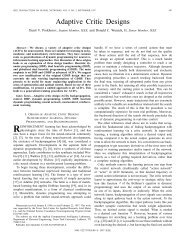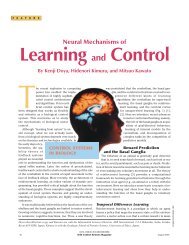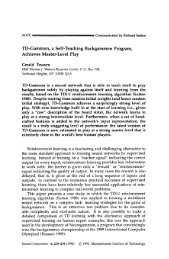ackgammon, it was the first organized tournament for computer <strong>program</strong>s.<strong>Neurogammon</strong> faced five opponents in the <strong>backgammon</strong> competition atthe Olympiad: three commercial <strong>program</strong>s (Video Gammon [USA], SaitekBackgammon [Netherlands], and Mephisto Backgammon [West Germany])and two non-commercial <strong>program</strong>s (Backbrain [Sweden] and AI Backgammon[USA]). Hans Berliner’s BKG <strong>program</strong> was not entered in the competition.All five <strong>program</strong>s apparently used single-ply search algorithms withconventional hand-crafted evaluation functions. In matches to 11 points,<strong>Neurogammon</strong> defeated Video Gammon by 12-7, Mephisto by 12-5, Saitekby 12-9, Backbrain by 11-4, and AI Backgammon by 16-1. With five matchvictories and no losses, <strong>Neurogammon</strong> convincingly won the gold medal for<strong>backgammon</strong> at the Computer Olympiad. <strong>Neurogammon</strong> also played fourunofficial matches to small numbers of points against intermediate-level humans,and won three out of the four matches. Finally, in an official challengematch on the last day of the Olympiad, <strong>Neurogammon</strong> put up a good fightbut lost to a human expert, Ossi Weiner of West Germany, by 2-7. Weinerwas clearly the better player, but the difference in skill levels was not as greatas suggested by the score. Weiner said that he was impressed by how muchthe <strong>program</strong> played like a human, how rarely it made mistakes, and that hehad to play extremely carefully in order to beat it.To summarize, there were two main ingredients behind <strong>Neurogammon</strong>’ssuccess at the Computer Olympiad. First, its doubling algorithm turned in avery solid performance: although its play was not technically perfect, it didnot make a single decision that would cause an expert to complain duringthe entire tournament. Second, in comparison to its opponents, its moveselection was very aggressive and much more in the style of a human expert.Several expert strategies and tactics used by <strong>Neurogammon</strong> (e.g., slotting,blitz attacks, and back games, to name some of the most prominent) appearedto be missing completely from the other <strong>program</strong>s.It was also interesting to observe the differences in the errors made by<strong>Neurogammon</strong> in comparison to those of its opponents. <strong>Neurogammon</strong>’serrors were mainly tactical in nature; its positional judgement was usuallyquite good. The other <strong>program</strong>s, however, usually made tactically acceptableplays (given their lack of knowledge of expert tactics), but often displayedbad positional judgement. This leads one to speculate that a facility to searchbeyond one ply would be more profitably added to <strong>Neurogammon</strong> than toa conventional <strong>program</strong>. A small amount of look-ahead can cure immediatetactical problems, but is unlikely to make a significant improvement in a<strong>program</strong> with fundamentally flawed positional judgement. Other possibleimprovements to <strong>Neurogammon</strong> are discussed below.5. Conclusions<strong>Neurogammon</strong> 1.0 demonstrates that a great deal of human expert knowledgein a complex domain can be learned by multilayer <strong>neural</strong> <strong>network</strong>s from largeexpert data sets. Its victory at the Computer Olympiad has significance forI11 - 37Authorized licensed use limited to: University of Illinois. Downloaded on August 15, 2009 at 19:24 from IEEE Xplore. Restrictions apply.
still engaged) stages of the game are precisely where <strong>Neurogammon</strong> currentlygoes most seriously wrong, learning from outcome could at least provide auseful supplement to what can be achieved with supervised learning, and atmost could be used to learn the entire game to better than human worldchampion level.References[l] H. Berliner, “Experiences in evaluation with BKG- a <strong>program</strong> that plays<strong>backgammon</strong>,” Proc. of UCAI, 428-433 (1977).[2] E. B. Keeler and J. Spencer, “Optimal doubling in <strong>backgammon</strong>.’’ OperationsResearch 23, 1063-1071 (1975).[3] B. Kennedy and C. Papazian, Backgammon Master Games. Palo Alto:Shima Publishing (1981).[4] Y. Le Cun, “A learning procedure for asymmetric <strong>network</strong>.” Proceedings ofCognitiva (Paris) 85, 599-604 (1985).[5] P. Magriel, Backgammon, Times Books, New York (1976).[6] D. B. Parker, “Learning-logic.” MIT Center for Computational Research inEconomics and Management Science Tech. Report TR-47 (1985).[7] D. E. Rumelhart, G. E. Hinton and R. J. Williams, “Learning representationsby back-propagating errors.” Nature 323, 533-536 (1986).[SI R. S. Sutton, “Learning to predict by the methods of temporal differences.”Machine Learning 3, 9-44 (1988).[9] G. Tesauro, “<strong>Neural</strong> <strong>network</strong> defeats creator in <strong>backgammon</strong> match.” Univ.of Illinois, Center for Complex Systems Technical Report CCSR-88-6 (1988).[lo] G. Tesauro, “Connectionist learning of expert preferences by comparisontraining.” In: D. Touretzky, ed., Advances in <strong>Neural</strong> Information Processing1, 99-106, Morgan Kaufman Publishers (1989).[ll] G. Tesauro and T. J. Sejnowski, “A parallel <strong>network</strong> that learns to play<strong>backgammon</strong>,” Artificial Intelligence 39, 357-390 (1989).[12] P. Werbos, Ph. D. Thesis, Harvard University (1974).[13] N. Zadeh and G. Kobliska, “On optimal doubling in <strong>backgammon</strong>.” ManagementScience 23, 853-858 (1977).I11 - 39Authorized licensed use limited to: University of Illinois. Downloaded on August 15, 2009 at 19:24 from IEEE Xplore. Restrictions apply.









